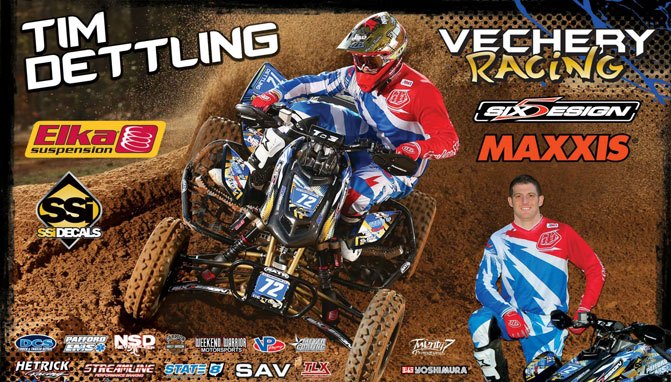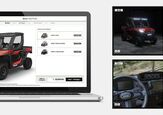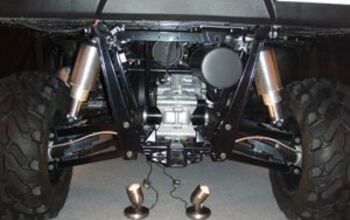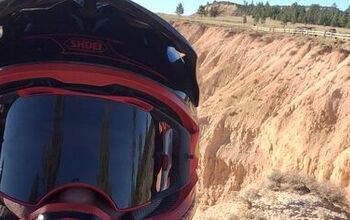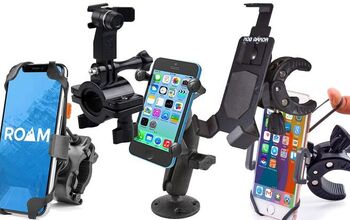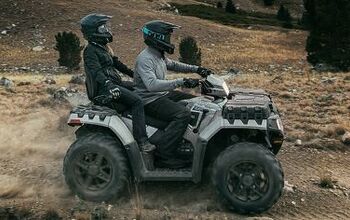ATV Racing Sponsorship Etiquette
Editor’s Note: ATV.com is going deep into the world of racing sponsorship with a three-part series. This is the second article in the series, which will look at how to best approach sponsors for support. Read Part 1 of the series here.
As a follow up to our recent article covering some of the economics of our industry and specifically how it relates to sponsorship and race support, we wanted to offer up some specific tips that you can use to increase your chances of receiving support for your ATV racing program.
These are specific details that might seem a bit overkill, but consider that companies receive hundreds of requests for sponsorship from racers all over the world. Every little thing you can do to make their job easier will benefit you in the long run and hopefully help you stand out from the crowd.
Make it Easy on Them
By now you probably understand that you’re going to need to submit a resume. Every company is going to want to know something about you, your racing history and how you plan to promote them and their products. Rather than sending a rogue email to an address you found online or mailing in a hard copy of your resume to a company’s physical address, start by finding out if a company offers racer support and how it prefers to receive applications to the program.
This information is usually provided on a company’s website. If you scour a website and are unable to find out if it offers sponsorship opportunities, pick up the phone and call. Don’t try to sell yourself over the phone, just find out if it has a support program and how you can apply. Most companies have a preferred method of receiving applications and following protocol is the first thing you can do to increase your chances of receiving support.
If the company requires all requests to be sent electronically and you send in a nicely put together, spiral bound portfolio, there’s a chance it could end up in the trash. It sounds harsh, but sponsors receive, review, and respond to hundreds of requests for support, so following the company’s policy is priority number one.
You would also be wise to ensure that all your contact info is included and easy to find, so a potential sponsor can get back to you as easily as possible. If all you include is a phone number, there’s a good chance you won’t hear back. Company representatives don’t have the time to call back every prospective racer. A quick email response will generally suffice.
Take out all the guesswork. Include your phone number, email, and even your physical address. Some companies still mail out contracts and expect racers to sign and return a physical copy. By including all this information, you’re making the company’s job easier by giving it everything it might need up front.
Email Etiquette and What Your Message Says About You
By and large, most companies will prefer seeing something electronically. It’s far easier to organize and respond to applications sent electronically than it is to maintain stacks of physical resumes on a desk or in a filing cabinet. That being said, there are some very important rules of etiquette that you should follow before you start emailing your resume to any and every company in the industry. How you conduct yourself in your correspondence speaks volumes about how you will represent a company should it decide to get involved in your program.
Start out by personalizing a cover letter. It doesn’t have to be lengthy, but it should be addressed to each company individually and explain why you are asking for support and how you believe its support will benefit your program. Sending out a generic “To whom it may concern” email with very generalized language sends the message that you don’t care enough to take the time to put together an attractive proposal. From the company’s perspective, this is seen as laziness and is probably an accurate reflection of how you’ll represent it to the rest of the racing community.
On that same note, never (and we mean NEVER) send out a mass email to numerous companies with your resume attached. It should go without saying, but we see it time and time again. Racers scour the Internet for contacts and lump them all into one blanket email, attach their resume and hit send. That’s a BIG no no and is a strong indicator that the racer is just looking for whoever will give him or her the best deal and has no real intention of representing the company. While a lot of companies understand that it can be difficult to ask for support and most don’t expect a masterfully crafted resume that looks like it belongs on a magazine cover, these group emails scream laziness and are most often sent directly to the trash.
The last thing we’ll mention on email etiquette is that you should proofread your resume and cover letter for typos and misspelling. With so much communication going mobile these days, it’s more commonplace to see text lingo spilling over into our actual communication. “i was wundering if U would sponser me ??” is not the first impression you want to make. Keep in mind that the people reviewing your application will most likely never meet you in person, so every correspondence with them is an opportunity to model professionalism and leave them with an impression that you take representing yourself and their company seriously.
Get Yourself Recognized
When companies are receiving and reviewing hundreds of resumes, eventually they all start to look the same. A brief bio, your racing career highlights, a few photos and maybe a paragraph about how you plan to promote them. That’s pretty much standard operating procedure. While we recommend including all of this information at a minimum, there are a number of ways that you can cover all these same bases, but do so in a way that is going to catch their attention and leave your name resting in their minds.
Consider hiring someone to create an eye catching, professional resume. A visually stunning proposal that obviously took some time to produce does two important things. First, it will stand out among other more basic resumes. Second, it tells the company that you are serious about professionalism and how you represent yourself. How you represent yourself is a telltale sign of how you will represent a sponsor. Think about it; who do you think takes the idea of sponsorship more seriously – the racer who attaches a few pictures and some bullet points to a Word document, or the one who pays someone to put together a high impact, visually appealing resume that could double as a poster for the wall? This is just another example of how your actions and attention to detail say a lot more than you might realize.
While we’re talking about visual appeal, here are a few things to consider when selecting photos to include. First, don’t include watermarked images. It’s commonplace to see photos on resumes that have watermarks from popular news websites, but in reality all that tells the person reviewing it is that you stole the photo from someone else’s website. If you find a photo of yourself online, contact the photographer and ask if you can use the photo or buy the original. Most are very accommodating and usually don’t charge an arm and a leg.
You don’t need to bombard them with an entire photo album, but consider including a few different photos that accurately illustrate who you are. A good action shot, a clean headshot, and a picture of your prepped bike or pit area. In regards to the pit area, if you can illustrate that you are LOUD in how you represent those people involved in your program with flags, EZ-ups, banners, etc, you are only making the job easier for the person reviewing your resume.
Nonverbal Communication
By now hopefully you understand that when it comes to seeking out sponsorship, how you go about it is every bit as important as what you have to say to the company. Every aspect, from your communication to how you represent yourself and the effort you put into requesting sponsorship, gives that company a good indication of how you will represent it as a sponsored racer.
In our next article we will talk more about specific ways that you can elevate your promotion game to a whole new level In this digital age, it is easier than ever to promote the companies that support you, whether you are winning on the track or not. Most companies who do social media and online content right are paying very close attention.
Growing up in Oregon, most of Seth's involvement in the powersports world was limited to what he saw in magazines and videos. Following a brief stint in the corporate world, Seth took a flying leap (literally) and moved to California to pursue a career in freestyle motocross. Though short lived, the opportunity immersed him in the industry and is now a well-established off-road writer.
More by Seth Fargher



